
Catalog excerpts
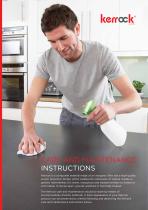
CARE AND MAINTENANCE INSTRUCTIONS Kerrock is a composite material made of an inorganic filler and a high-quality acrylic polymeric binder, which creates the impression of natural marble or granite, nevertheless it is warm, nonporous and treated similarly to timber or soft metals. It can be sawn, ground, polished or thermally treated. The Kerrock care and maintenance should be done by means of environmentally-friendly methods. A fresh appearance of your Kerrock product can be preserved by merely following and observing the Kerrock care and maintenance instructions below.
Open the catalog to page 1
CARE AND MAINTENANCE OF KERROCK SURFACES HOW TO CLEAN KERROCK KITCHEN SURFACES, WASH BASINS AND SINKS FOR EVERYDAY CLEANING Even though the liquids cannot penetrate into Kerrock, it is best that you immediately wipe the spilled stain with a dry cloth. Rinse the stain with warm water and clean Kerrock with a soft microfiber cloth and a normal household detergent or cleaning agent (Pril, Cif, Mr. Muscle, Meglio, Ajax, etc.). Always clean in a circular motion. FOR PERSISTENT STAINS such as coffee, tea, fruit or vegetable juices, red wine, ketchup, ink, pen, colouring agents Wipe the spilled...
Open the catalog to page 2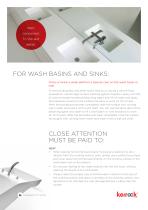
Wellconceived. To the last detail. FOR WASH BASINS AND SINKS: Once or twice a week perform a beauty care on the wash basin or sink. To remove all greasy and other stains that occur during a normal food preparation, use stronger surface cleaning agents. Prepare a spray with 3/4 of chlorine-based household bleaching agent and 1/4 of water, and spray the prepared mixture on the surface and allow to work for 10 minutes. After the procedure has been completed, rinse the surface with running warm water and wipe it with a soft cloth. You can use the same ratio of the bleaching agent and water to...
Open the catalog to page 3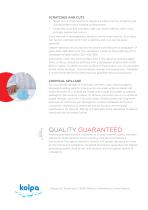
Never cut or chop directly on Kerrock surface, but for chopping and cutting always use a suitable cutting board. Scratches, dust and everyday wear are more visible by dark, more strongly pigmented colours. Since Kerrock is homogeneous along its entire cross-section, its surface can be fully restored, and minor scratches and cuts can be easily removed. Deeper abrasions and scratches should be polished with a sandpaper of granulation 180–220, until they disappear. Continue the polishing with a sandpaper of granulation 320–400, 600. Afterwards, clean the entire surface with a fine abrasive...
Open the catalog to page 4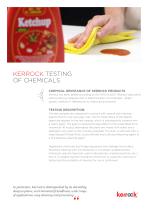
KERROCK TESTING OF CHEMICALS CHEMICAL RESISTANCE OF KERROCK PRODUCTS Kerrock has been tested according to ISO 19712-2:2007 (Plastics-decorative solid surfacing materials, Part 2: Determination of properties - Sheet goods), method A (Resistance to chemicals and stains). TESTING DESCRIPTION: The test samples are subjected to contact with several stain-leaving agents found in our everyday lives. Two to three drops of the tested agent are applied to the test sample, which is subsequently covered with a watch glass. The agent is allowed to take effect for the prescribed time (maximum 16 hours),...
Open the catalog to page 5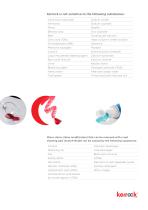
Aluminium hydroxide Ammonia Petrol Bensoic acid Beer Citric acid (10%) Formaldehyde (39%) Meat and sausages Lipstick Liquid household cleaning agent Boric acid tincture Urine Bleaching agent Hand cream Toothpaste Sodium nitrate Sodium sulphate Paraffin Zinc sulphate Cooking salt solution Yeast culture in water solution Glycerine Mustard Iodine solution (medical) Calcium hydroxide Calcium chloride Kalcijev klorid Hydrogen peroxide (30%) Alkali and soapy water Animal and plant fats and oils Minor stains (shine modification) that can be removed with a wet cleaning pad (Scotch-Bride) can be...
Open the catalog to page 6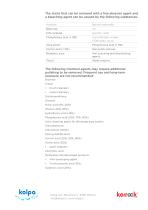
Acetone Black tea Ethyl acetate Phosphorous acid (< 9%) Shoe polish Formic acid (< 9%) Blueberry juice Barium hydroxide Ink Gentian violet Concentrated vinegar (30% acetic acid) Phosphorous acid (< 9%) Nail polish remover Hair colouring and discolouring agents Water crayons The following chemical agents may require additional polishing to be removed. Frequent use and long-term exposure are not recommended: Bromine Cresol • brush cleansers • metal cleansers Dichloromethane Dioxane Nitric acid (9%, 20%) Phenol (40%, 85%) Hydrofluoric acid (48%) Phosphorous acid (20%, 75%, 90%) Acid cleansing...
Open the catalog to page 7All KERROCK catalogs and technical brochures
-
PROCESSING INSTRUCTIONS
38 Pages
-
Ventilated Kerrock façade
56 Pages
-
Kerrock coverings
56 Pages
-
CATALOGUE DES COULEURS 2018
28 Pages
-
CATALOGUE VASQUES ET CUVES 2018
92 Pages
-
KERROCK.
84 Pages
-
WASHBASINS AND SINKS.
40 Pages
-
FACADES.
24 Pages
-
MEDICINE.
36 Pages
-
HOTELS.
20 Pages











